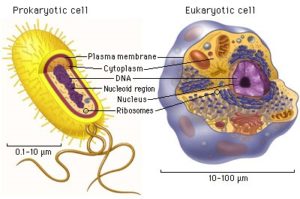Cells (AQA AS Biology) PART 2 of 6 TOPICS
|
Structure of prokaryotic cells:
Prokaryotic cells are different to eukaryotic cells in many ways: 
- They are smaller to eukaryotes
- They have no membrane-bound organelles
- They have no nuclei but a loop of DNA
- They have murein (a glycoprotein) in their cell walls
In addition prokaryotes have structures such as having more than one plasmids, a capsule surrounding the cell and more than one flagella.
Viruses:
Viruses are a-cellular and are non-living. They have a protein coat with a nucleic acid in the middle (DNA). It has an attachment protein which attaches to a cell.
NB: As part of AQA, only the illustration of complex and spherical viruses need to be known. Above is a description of a complex virus and spherical is where HIV is under
which will be covered in later topics.
] That is all for the structure of prokaryotes and viruses [
